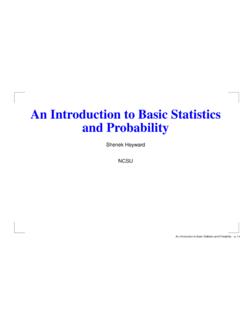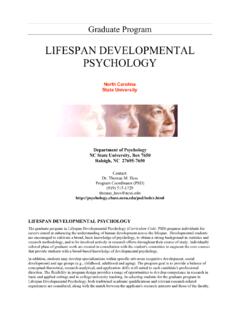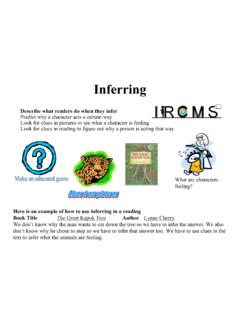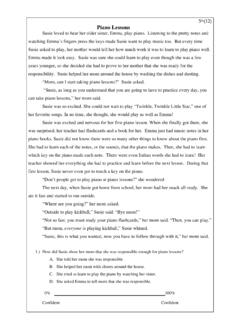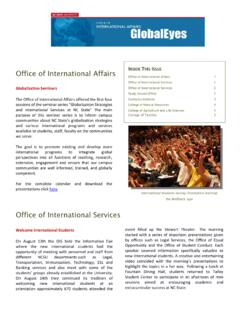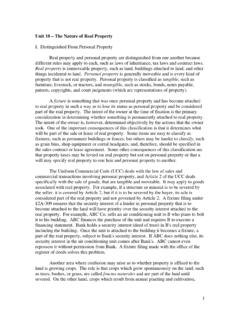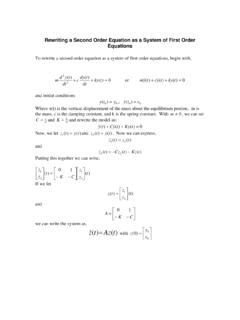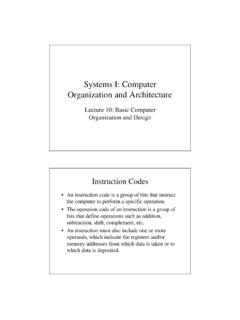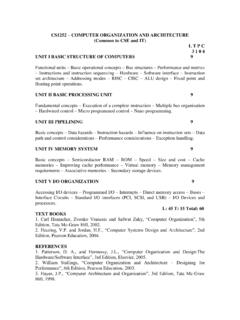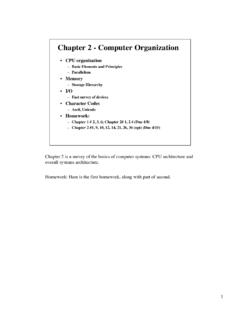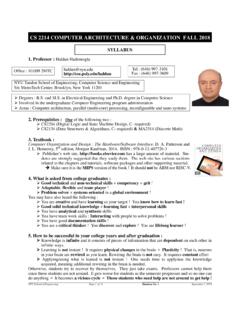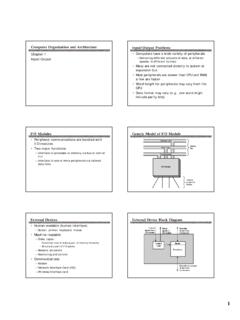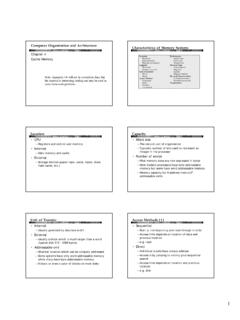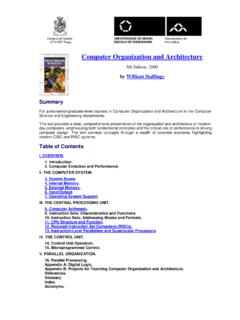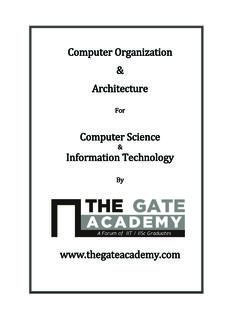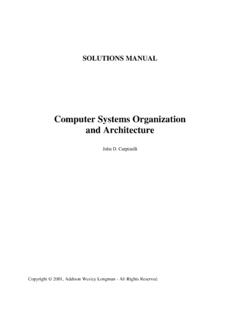Transcription of A lab course of Computer Organization - Nc State …
1 A lab course of Computer Organization J. Real, J. Sahuquillo, A. Pont, L. Lemus and A. Robles {jorge, jsahuqui, apont, lemus, Computer Science School Department of Computer Engineering Technical University of Valencia (Spain) Abstract Lecture topics in Computer Organization courses offered by different Universities around the world do not differ significantly. This is because, in general, lecturers use the same textbooks and are inspired by common curriculum sources. However, lab courses and project assignments require more and more expensive resources (computers, assemblers or assembler simulators, logic circuit simulators, ..) This fact, together with the rapid advance of these tools, causes lab courses to widely differ among universities. This paper summarizes the lab course on Computer Organization offered this year at the Technical University of Valencia, Spain.}
2 The course is composed by several experiences and jobs, each one aimed at working on one specific topic. Our goal is not only to introduce the tackled topics, but also to discuss some characteristics of the tools. All the tools used are freely available, which is a must for the students to be more motivated and to be able to extend their work using their own computers at home. 1. Introduction and motivation The Technical University of Valencia offers a three-year Bachelor degree course in Computer Engineering. A modification of the curriculum has recently been undertaken to adapt it to the new trends and professional outlines. The recommendations from the IEEE/ACM Computing Curriculum 2001, as well as curricula from some relevant Spanish and foreign universities have influenced the new design.
3 The course includes 60 lab hours (25% of the total), distributed along two core courses in the first and second year. Each course is attended by more than 800 students, which strongly impacts on the lab Organization and the type of experiments. Up to 40 students attend each lab session, working in groups of two people. Theoretical lectures are attended by up to 120 students. To properly design the lab course it is necessary to consider the contents of the theoretical courses, the academic year when they are given and, specially in our context, the high number of students, which this is not a trivial task. One of the main problems is to choose appropriate tools for the lab experiences. An excessive use of abstract simulators is a risk because some of them (specially those very didactic) are quite far from the real world.
4 On the other hand, the contents of the Computer Organization subjects are very difficult to implement in a practical way without additional technical knowledge. Finally, the tools and equipment needed for the lab sessions tend to be expensive. Some universities propose lab courses based only on a part of the subject (generally the part whose contents are easier to practice in the lab) and they do not cover, in a practical way, the whole theoretical contents. The main reason is usually the lack of appropriate tools to do it. The structure of this paper is the following: section 3 briefly describes the theoretical course of Computer Organization ; section 4 details the lab course , both describing the experiences and the needed tools; section 5 presents the time schedule of the theoretical and lab courses.
5 Finally, section 6 summarizes our conclusions. 2. Computer Organization theoretical course The Computer Organization course is a core subject of the Computer Engineering degree. This course is given along the first and second year of the degree, having assigned up to 180 lecture hours in all (90 lecture hours each year). Evaluation is performed in an annual basis. The main goal of this course is to introduce the students to the Organization of Computer systems through the study of each one of the functional units that compose them. Topics include data representation, digital logic, assembly language, simple processors, memory unit, input/output unit, arithmetic-logic unit, basic pipelining, and advanced processors.
6 Tables 1 and 2 show the themes into which each topic is broken down and the number of hours assigned to them. This information corresponds to the syllabus of the first and second year courses, respectively. Syllabus (First year) Topic Themes Hours Introduction 1. Introduction to Computer systems 2 Data representation 2. Data representation 9 3. Basic concepts of digital systems 12 4. Combinational systems 10 5. Sequential systems: Flip-flops 4 Digital logic 6. Sequential systems: Registers and counters 8 7. Introduction to assembly language 10 8. Assembly programming 6 Assembly language 9. Procedures 6 10. Datapath 10 11. Control unit: Hardwired realization 8 Simple processors 12. Control unit: Microprogrammed realization 5 Total hours 90 Table 1. Syllabus of the first year course on Computer Organization .
7 Syllabus (Second year) Topic Themes Hours 13. Memory system 3 14. Memory system design 10 Memory unit 15. Memory hierarchy 10 16. Input/output devices 9 17. Input/Output management 12 Input/Output unit 18. Buses 4 19. Integer arithmetic unit: Adders and subtracters 6 20. Integer arithmetic unit: Multiplication and division 8 Arithmetic-Logic unit 21. Floating-point arithmetic unit 4 22. Introduction to the pipelining 6 Basic pipelining 23. Pipelined processor 12 24. Examples of contemporary processors 4 Advanced processors 25. Introduction to multiprocessor systems 2 Total hours 90 Table 2. Syllabus of the second year course on Computer Organization . 3. The lab course We propose a selection of experiences on Computer Organization , aimed at covering the classical Computer functional units: processor, memory, and input/output system.
8 The lab course goals complement those of the classroom course . We have designed and selected some experiences, trying to balance the course time among the mentioned functional units according to their importance. The aim is to acquire an elementary but complete knowledge about Computer Organization as well as its basic working principles and underlying design aspects. We also discuss the selection of a set of free software tools that allow those students requiring additional time, or those who show further interest, to continue their work at home. The described experiences are organized in lab sessions, each taking two hours of work. Experiences Experience 1: Assembler Three lab sessions are dedicated to implement simple assembly language programs.
9 The topics are assembly instructions (bare machine) and pseudoinstructions, instruction coding, data representation, and functions in assembly language, exercising the MIPS register usage convention. The first session is an introduction to the PCSpim interpreter [spim02] that simulates how the assembler works for the MIPS architecture . The session lab is addressed to give the students practice with several features of the tool, and to strengthen some topics studied at the classroom, like character, integer and floating-point representation, as well as memory data alignment. The second session has three types of exercises. The first one deals with the instruction coding. Students must codify some assembly language instructions and check if their results match to those given by the tool.
10 The second one is addressed to check the results of some instructions that use predefined target registers ( , LO and HI for integer division and multiplication instructions). The last one is addressed to running a program that performs the scalar product of two vectors. Students must run the program and answer some questions: i) to determine which function it performs, ii) to identify the pseudoinstructions of the program, and iii) to explain why the assembler not always codifies a given pseudointruction by using the same machine instructions ( , the load address instruction). In the last session, the students must break down the scalar product program in two parts: main program and procedure. The programs must be implemented by using the callee-saved as the procedure call convention.

